Introduction
When was the last time you conducted a comprehensive inventory and evaluation of your content? Conducting a content audit is modifying your old content to rank them on search engines, and it can take an enormous amount of time. So, how to do a content audit?
If you are new to content auditing, our “How To Do A Content Audit Guide” will provide you with the ideal spot to learn all you need to know.
Conducting a thorough overview of your website's content is referred to as a "content audit." When you do a content audit on your website, you can see how well your optimization activities are aligned with your organizational objectives.
When you do it properly, you can identify and correct any flaws in your content to serve your target readers better. Through the content audit of your site, your audience will be able to discover and benefit from your content more effortlessly.
Creating and disseminating fresh content could be the first step in reaching your content marketing objectives. Now consider how you will set everything up. How do you monitor the performance of your content? In what ways do you plan to use this data in the future?
Many content strategists and SEOs underestimate the impact of content audits because of their intricacy or the duration of the procedure. To get the most out of your website’s content, you need to conduct a regular audit of your site’s content.
What is a Content Audit?
A content audit examines the content of a business or an individual, as well as the overall performance of a website. It puts all of their specific KPIs and content to the ultimate test.
For example, you have a lot of blog entries on your website that include stats and charts. They used to be listed in search results but no longer are. As a result, your website is losing both money and visitors.
Performing a content audit can help you recoup lost readers and make revenue by ranking on search engines like Google, Bing, etc.
In a content audit, online assets like blogs are reviewed and tested. Content audits maintain track of all the content on a website and help determine what should be added, updated, rewritten, or deleted.
For example, you have a website with a lot of content. There is some information on your website that you wrote, say, two years ago. There are a lot of out-of-date facts.
Your audience will be misled if they read the contents of such articles. As a result, you should regularly update, add, and delete information to ensure that your content is up to date. This is called a content audit.
There is a lot of confusion between content audit and content marketing. These are different ideas.
Why should you do a Content Audit?
Your content audit will assist you in keeping your content fresh, boosting your page rank, and making your website user-friendly and error-free. You can conduct content audits are for primary two reasons:
SEO
An SEO content audit identifies any SEO problems in your site’s content. It should be possible to establish what modifications need to be done to enhance your site’s natural search performance by cataloging the keywords, word counts, optimized pictures, and other factors.
SEO is vital to maintaining fair search results. These results can no longer be artificially manipulated, making it easier for people to find what they want.
People believe in search engines; thus, a high rating in search results shows that your site is trustworthy. A higher ranking on search engine results pages means more traffic and clicks.
Without SEO, you can encounter these problems-
- Google won’t rank your page
- Your content won’t gain organic traffic
- Your content won’t generate any money
- People won’t trust your content
- Your brand won’t be promoted

Boosting your Content
A Content audit is a great way to assess your content marketing. Then you can see how your audience responds to each piece of content you publish without focusing on on-page SEO concerns.
For example, we conducted a content audit on one of my client’s sites PCB May in the last year.
Recently, they have seen a decline in several of their older posts that were popular (in terms of Google rankings and traffic). A content audit was on their wish list. So they came to us, and we did our best to help them in every way we could. They have risen to the top of Google’s results now.
So we set out to enhance that content using the best practices you will learn. And these suggestions were a big help as well.
If you boost your content, you may anticipate a 50% to 60% rise in traffic to your content in the following six months. Do not hold your breath, waiting for immediate results. Unless, of course, you are a terrific writer with a well-known website that publishes consistently high-quality material.
One content audit increased my site’s traffic from search engines by a whopping 38.43 percent!

What Tools Are Necessary For A Content Audit?
The content audit is an enormous and often exhausting task that you may accomplish alone. You might also assign part of the work to a coworker. Do things slowly, step-by-step, at your speed, and be patient with yourself. If you are still not convinced, you may always employ research automation tools.
Here are some of the tools you can use:
Screaming Frog
Screaming Frog is the most widely used and recommended among web crawling tools. The free membership version of Screaming Frog can crawl more than 500 URLs and preserve data exports. Those that work in marketing find it to be a handy resource.
As opposed to this free utility, URL Profiler requires a paid subscription to use. Using URL Profiler will help you better your content audit chores and offer you raw new information to examine.

Screaming Frog Website
Google Analytics
Google Analytics is an analytics tool that offers you information, and you can use it for SEO and advertising. The service is available to anybody with a Google account at no charge.
You can use Google Analytics to monitor the website’s operation and get information about your visitors. It can help your company in identifying the most popular user traffic sources.
Moreover, they enable you to monitor goal completions, identify trends and patterns, and gather additional user information.
SEOs use Google Analytics to track page views, bounce rate, conversions data by site, time on page, etc.
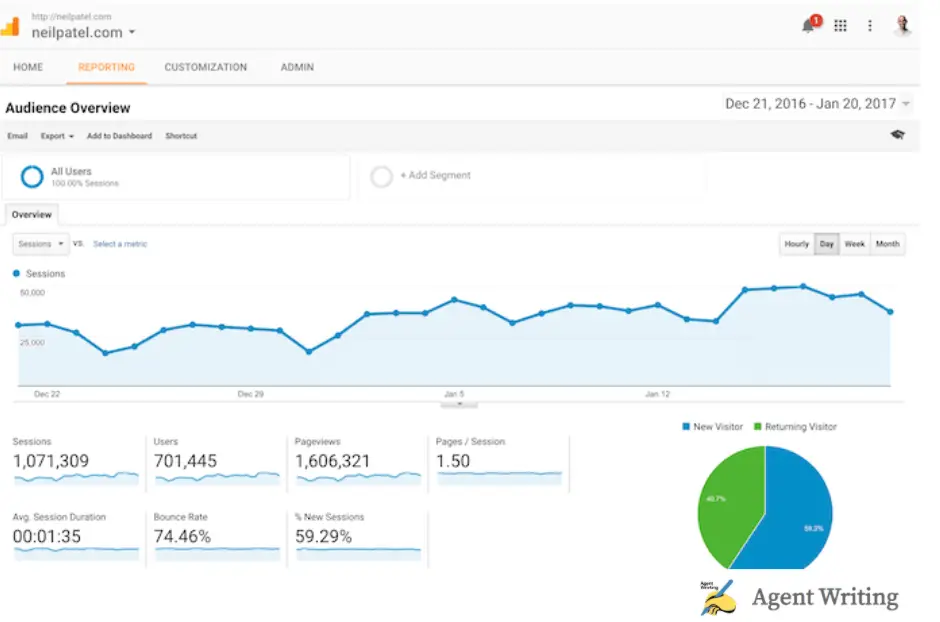
Yoast SEO
Using the Yoast SEO plugin, you may do a complete analysis of your content on your WordPress site, which will help you optimize it for searchability.
If your article is based on the WordPress platform, you should use Yoast SEO.
It has several functions to assist you with site layout, while others are more technical and can help you with content optimization.
When writing a blog, one of the most valuable features is the writing audit, which makes it simpler to optimize the article for a particular keyword.
Moreover, the tool becomes increasingly valuable as your site grows in popularity. To put it another way, if you publish content once a month, it will almost certainly be advantageous.
This will be essential if you are writing several times since it will allow you to scale out your blog without retaining editorial integrity.
All of these benefits, however, come at a cost. Annual fees for this service are set at $99.
Google is updating their database frequently, you should keep your content updated too. Writing SEO articles can be challenging. Our article on how to write SEO articles 2022 can help you overcome this,
Pro Tips: Rank Math is the best alternative to Yoast SEO. It gives you many premium features for free, which Yoast SEO is charging at a premium.

Ahrefs
Using Ahrefs has been one of the best decisions we have made for our site.
Its many features are domain and site research, link reporting, rank tracking, and more. There you have it: the “basic” SEO reports. They go above and above to provide useful data like ‘top pages,’ which shows which articles on a website (yours or competitors’) are perhaps the most valuable.
According to relevance, the Ahrefs software bundle has all of the tools marketers need for link building, keyword research, a site audit, competitor analysis, and rank tracking.
You can also discover which keywords your rivals are ranking for, but you are not in the “Content Gap” analysis.
As a general rule, Ahrefs is the best SEO and content-related tool on our list. Useful for planning, investigation, tracking, evaluation, and auditing of all kinds of information on the web. Semrush, a tool that is quite similar, is considerably more popular.
Keyword research can be a difficult and time-consuming process. Our guide on How to Do Keyword Research will be of great use to you.
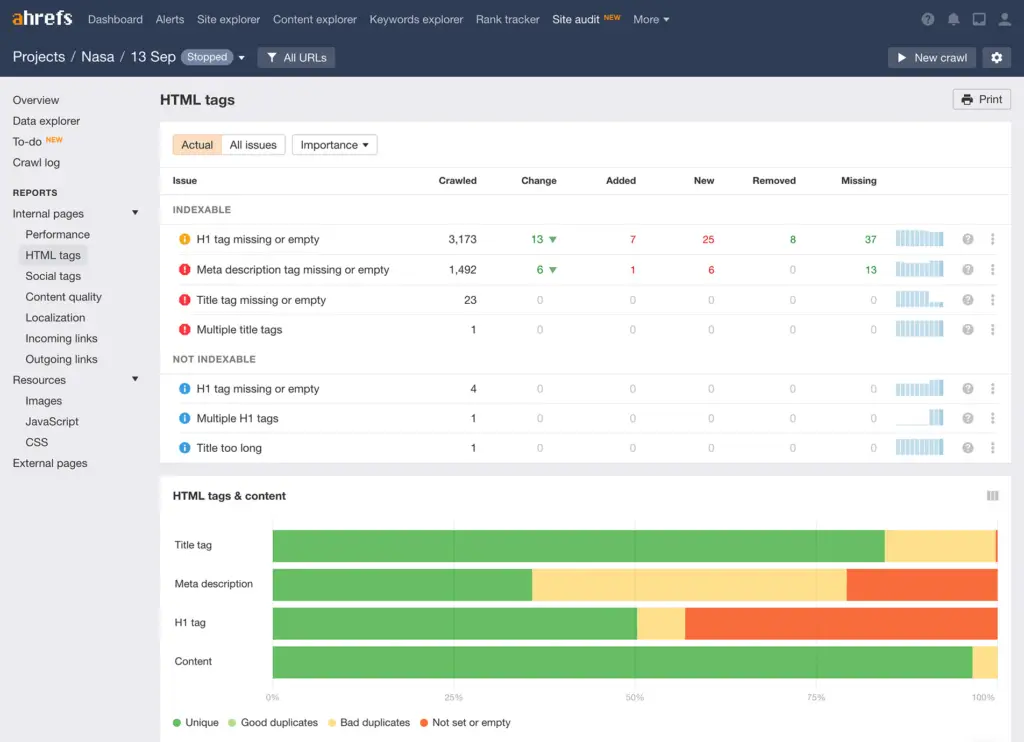
Semrush
The SEMrush Content Audit tool checks your site content. You can see shares from Facebook or Twitter, metadata, content writers, and backlinks. If you link Google Analytics to your site, it will allow you to get more data collection.
The application monitors articles’ keyword ranks, comments, backlinks, and traffic daily, and it does so in real-time.
These analytics tools can help your content audits if you want to collect more information from a larger number of sources, such as social media.
- Google Analytics supports you in analyzing which content is generating the most organic traffic, engaging with visitors, and converting them into customers.
- Position Tracking of SEMrush helps you keep track of specific keywords rankings. This tool may assist you in identifying material that has strong SEO potential. By regularly modifying your sites, you can climb in search engines (like Google, Bing) ranks faster.
- The ContentWRX Audit tool provides data on file formats, metadata, and page-level features such as photographs, files, clips, and images. In addition, you will organize your findings and export them for further use.
- Finally, the SEMrush Site Audit is an excellent tool if one of your primary audit objectives is to increase your website ranking. It may help you solve your website issues and thus lets your website run flawlessly.
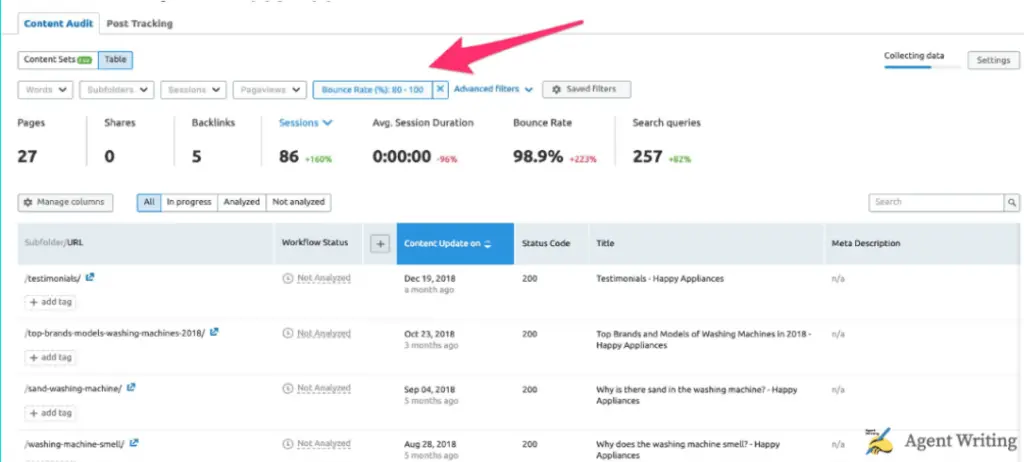
What should you expect from your content audit?
You need to know why you perform a content audit before you start. There is no use in doing an audit if you are not going to act on the results, right?
After conducting a content audit, you should anticipate the following actions to take place:
- Find ways to improve your site’s organic searchability.
- Discover which of your most successful content.
- Identify which topics your audience is reading the most.
- Look for areas where your content falls short at various points in the sales process.
- Merge pages with similar information to save space.
- Draw attention to sites with high views but poor conversions.
- Create content ideas for the future
- Remove information that is no longer relevant to your company, specialty, or corporate identity.
That is what I am saying, at least in theory. All right, let us put it into action!
Metrics To Measure and Monitor
You can use content marketing KPIs to measure and monitor your progress since the figures provide you with a specific point of truth. They are also critical for your site’s health and performance audits, so do not skip them.
To conduct a content data audit, you will want to keep track of the following metrics:
Pro Tips: With Google Analytics as well as Google Search Console, you can collect most of this data, but you’ll need an audit toolset, including AHREFs or Screaming Frog.
Comments
If you have a good comment area, your blog entries and posts will benefit from the contributions of your readers. If you don’t allow comments on your site, try checking the feedback about the post on social media.
Organic Searches
You want many people to find your content by searching for it naturally on search engines like Google. A lack of organic search traffic could be a warning sign for your website’s success.
The problem can be:
- Your content strategy
- Type of content
- Your content distribution strategy
- The content
By frequently examining organic traffic numbers in your audits, you will know when to celebrate and when to start again.
Shares on Social Media
Some marketers consider social sharing as a gimmick. However, by tracking your content’s social popularity, you can determine which themes are most likely to catch the attention of specific social audiences.
It is a good idea for businesses who know that most of their sales come through Facebook to generate popular content with Facebook users.
Analyzing which articles received the most Facebook shares in the past can help you predict future success.
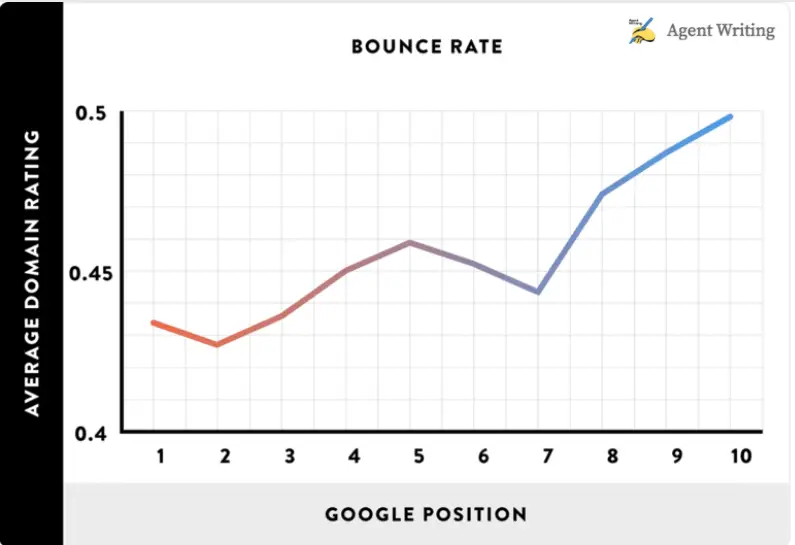
Bounce Rate
Are your visitors quitting your website after reading only a few items on your website?
When a visitor leaves your site without taking any further action like a click or scroll, Google Analytics records this as a “bounce.” Bounce rates indicate the quality of your site’s content.
A person searches on the internet and is sent to your website, where they are entertained or informed, visiting more of your content per their needs.
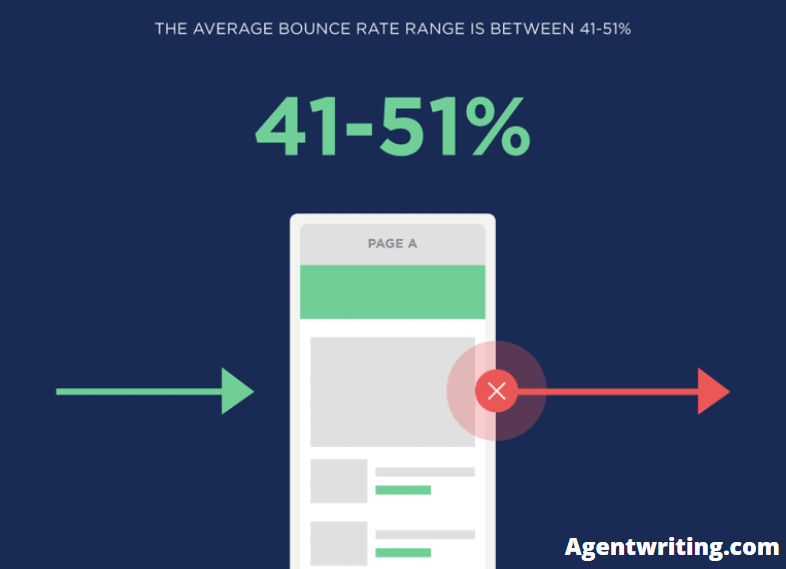
The longer a person spends on a page, the more likely they will return to your site and read more of what you have to offer.
How much is considered as an ideal bounce rate?
26% to 40% is what many people think is the best range. As high as 55% could be the average range.
Figure- Average Bounce Rate
On-Page Time
If your 3000-word blog article has an average duration on-page of 30 seconds, there’s something amiss.
This metric will tell you whether your content is suited for your reader or if you need to develop additional content on similar topics.
Backlinks
High-quality backlinks can bring your website a boost and a lot of credibilities. Always keep an eye on the backlinks quantities that your content generates daily.
Users: New vs. Returning
What kind of audience are you reaching with this content?
It is always nice to see users coming back. And nothing beats the returning customer. Our content should likewise be geared toward bringing in new people. A mix of both is ideal for our site’s success.
Sources of Internet Traffic
By establishing your primary traffic sources, you can discover where your visitors are coming from. If most of your traffic comes from Facebook, you should publish more content there.
If your email newsletters are not generating any leads, you should reorganize your emails.
Conversions
The number of conversions might represent many different things; thus, this is a far better statistic for auditing the content of landing pages. Setting up goals in Google Analytics, on the other hand, could be beneficial.
Content Audit Template
A content audit template helps in the auditing of your content inventory in order to discover weaknesses and obtain insights into your content management.
This template from Hubspot will walk you through the process of evaluating your website’s On-Page SEO.
It works for various page kinds, including the home page and blog page, among many others. The template has a section for noting the page type, which helps maintain the template well-organized.
The content audit template helps you in better understanding your current content. Make use of it to gain a handle on your content inventory, which may include word limits, metadata, media assets, and other information.
Expert Tip: If you manage multiple websites with a large amount of content, a content audit template can save you both time and money.
The following are some of the benefits you can get using a content audit template:

An inventory template for structured content
- Content audit guidelines
- Starter criteria
- A progress monitor
- A section for your data
Content Audit Flowchart
This content audit flowchart should give you a clearer picture of what has to be done and what does not.

How to Conduct a Content Audit: A Step-by-Step Guide
A content audit is a lengthy, yet very effective process. However, there are five crucial steps to follow to conduct your audit correctly.
Figure- How to Conduct a Content Audit
Step 1: Set your goals and success metrics
To ensure the success of your content audit, you must begin with well-stated goals from the beginning of the process. When you do not have a clear target in mind, it is easy to become sidetracked by the appealing but irrelevant ideas you uncover.
The goal of a content audit is to find the most entertaining and appropriate information for your intended audience. It may also contain data about search engine optimization and conversion rate.
One thing to consider is determining which of your sites needs to be optimized for search engine visibility. You may also consider putting the most popular and engaging material on your website homepage or in the newsletter.
Step 2: List Your Content
Before creating a list containing URLs and measurements, decide what type of data you want to examine. Additionally, you can evaluate other forms of information, like videos, PDFs, or interactive content, like quizzes and exams.
Manage The URLs
Starting the inventory procedure, you must collect the URLs of the relevant websites.
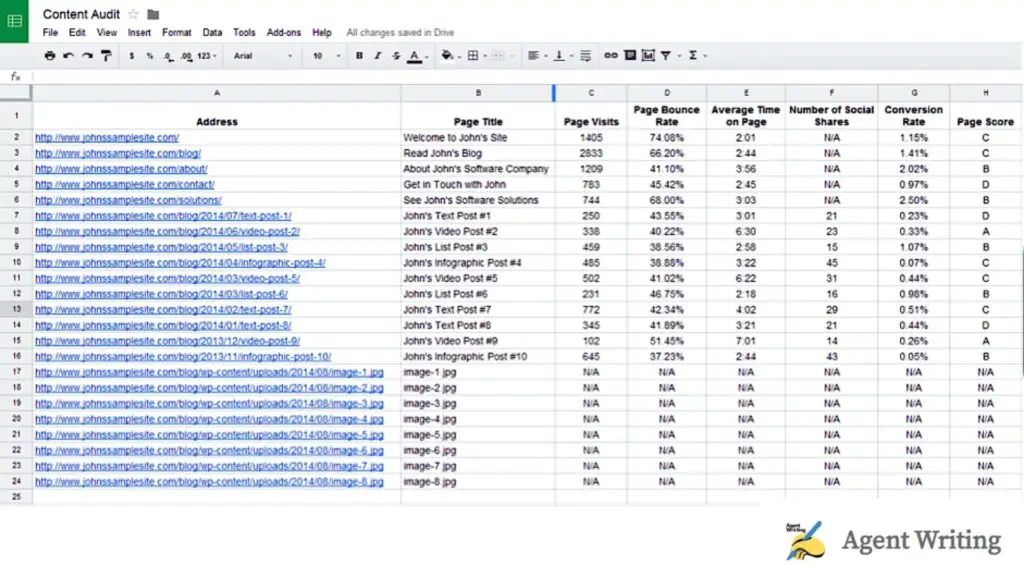
Organize Your Content
Once you have gathered your URLs, organize them into categories and share them with your group
The following are possible classifications for your content:
- The stages of the buyer’s journey
- A blog post, handbook, product description, or landing page
- Format of your content
- Word Limit
- Date of publication
- “Content cluster” or “Content hub”
- The writer
It is important to have all of your content’s title, meta tags, and header tags in one place. So you can check and update the data and information.
Last but not least, build columns for each of your metrics to gather data. To give you an idea, here’s a content audit template:
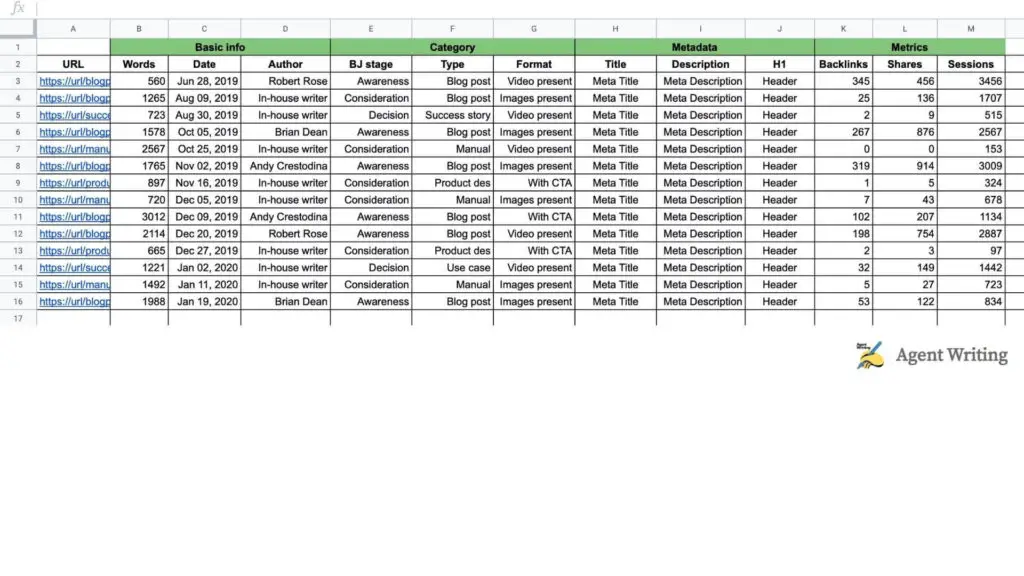
Step 3: Gather and Evaluate the Data
There is a great deal of work involved in collecting data. Often, you will have to manually gather data from different sources and enter it into a spreadsheet. This may be time-consuming. Content audit solutions can help reduce the time by capturing the data you need to track your desired objectives and KPIs again and again.
Use Google Analytics and search console data together to get a complete picture of your business’s online presence. Page visits, on-page time, indexed results, and bounce rate are just some of the additional data available for each URL.

Content Audit Data: How you can Analyze
Many people may visit your web page, but they may only stay for a short time before leaving. This suggests readers are curious about your topic, but your content lacks what they want.
If you want to know why your visitors are leaving your site, you need to analyze your content. Your content’s relevancy to titles, Calls to action, or page load speed may be the source of the issue.
Assess the value of your content
Evaluate every content against your goals and give one of the three statuses:
Maintain
Consider reusing the content as an element of your overall content marketing plan. Accomplishments, FAQs, and basic information about your company are examples of evergreen content.
Improve
Review the content and see if there are any changes you can make. You can always update your outdated content.
For instance, the statistics of your blog, outdated graphs, charts, and low-traffic articles.
Remove
If you cannot update content or update it would take too long, consider eliminating it from your site. You can use a Content Audit tool to group your pieces into sets so you can analyze your content better.
- Remove or rewrite the outdated articles
- Update the old pages
- Review recently visited pages and consider ways to enhance them.
- Identify poor content on your site.
According to Ahrefs, they did a content audit and removed 31.7% of the website content. This increased their website traffic to 7.57% in two months.

Step 4: Establish an approach
Your next step should be building a strategy for improving your content. Develop an action plan based on your research.
Address Your Preferences
First, decide which tasks are most important based on the work necessary to achieve your company’s goals.
Include a priority column in your chart after assessing the resources needed against the anticipated outcomes.
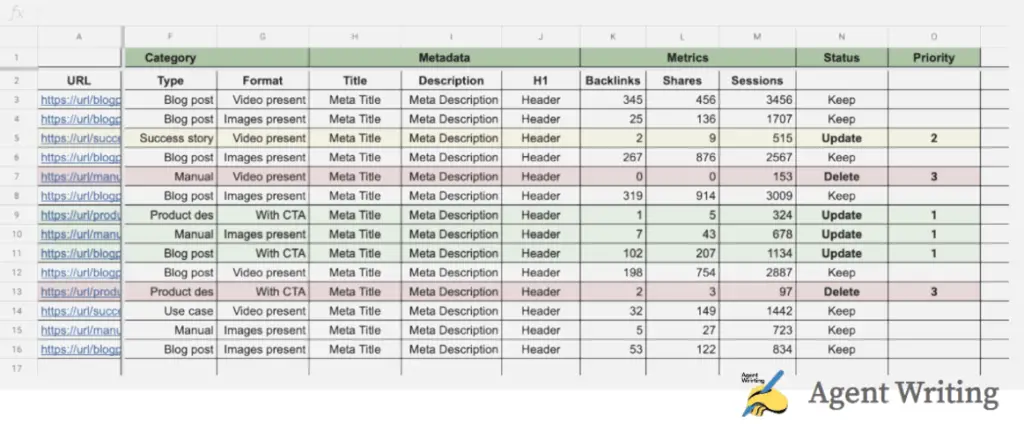
Each URL should have an action plan created for it.
Develop an action plan after you have prioritized your list of contents. Here are some real-world examples of what you can include in your content audit for each page of your website:
Rework your content
Combine several bits of content into a new one or post it uniquely.
Customize your content
The success of your blog entries might be boosted by rewriting them with updated examples, instruction, and practical information.
Update your content
Add pertinent material to your content rather than rewriting the whole piece.
Organize your content
Using appropriate H2 and H3 headers can help visitors and search engines better understand your content, increasing traffic. It is also more probable for your Featured Snippets to be well-written tutorials.
Review the CTAs
Check out the outdated banners on your website. If you want to boost your conversion rates, you should substitute them with more relevant offers to the user.
Incorporate videos
According to a poll of Wyzowl, 87% believe that including videos enhances website traffic. 81% of respondents indicated that readers like to spend more time on websites with video.
Include pictures
To increase your website’s visibility and traffic, you can either use Google Images to enhance the quality of your content. A website should incorporate multimedia features like videos and pictures on search engine results pages.
Intensify the metadata
Try to modify your titles, metadata, and header tags. Include additional keywords in your content to make it seem more natural to consumers and search engines.
Improve internal linking
Posts on your blog on relevant subjects should include links to fresh articles. This can help streamline the structure of your website and lower the number of visitors who leave without taking any action.
Whether you are writing new content or optimizing old ones you should know the basics of SEO writing. Read our detailed guide on how to write SEO articles.
Step 5: Make Modifications to Your Content Marketing Plan
Keep in mind your long-term marketing plan while conducting a website content assessment. If you monitor your strengths and weaknesses, you can alter your content strategy to attract your intended audience in new ways, modify assets for improved organic traffic, and enhance conversion rates.
Learn from your successes and build on them. Examine your least effective content and your rivals to identify how and where you can change.
Every year, you should review your content marketing plan to ensure your strategies and actions align with your company’s goals. Regular reviews are necessary if your industry undergoes frequent change, such as once a month or a quarter.
Your audience expects you to stay on top of their shifting expectations; therefore, you must always seek new and creative ways to connect with them.
A Checklist for Website Content Audit

Check out this quick overview of how you can conduct your website content audit:
- Your content audit should have a precise business aim, such as increasing your SEO results and audience engagement. Use relevant data, including organic search traffic, ROI, and bounce rate, to match them.
- Organize your material by buyer’s journey phases, types of content, writer, and other areas that are essential to you by collecting URLs of your content.
- You should use analytical tools to gather performance statistics on content assets.
- Analyze your content assets based on predetermined metrics, then decide whether or not to keep, update, or eliminate them.
- Decide which tasks are most important based on your company objectives, then create a plan of action for each one.
- At least once a year, assess your content strategy and adjust it accordingly.
Related Knowledgebase for you
Frequently asked questions
1. How much do content audits cost?
The cost of a content audit depends on the size of your site and the amount of content you have on your site. You can expect a cost of $650-$20000 for your site content audit.
2. What is a rolling content audit?
The rolling content audit maintains track of your important KPIs from an initial inventory, which is updated regularly. To encourage data-driven content, the real-time stats are reviewed frequently.
There is no better way to maintain records on what has been added and what has been changed or deleted than having a person do a rolling audit of the site’s content.
3. Can I have more than one content audit done at the same time?
Obviously, I say. To meet your specific requirements, we may do many site audits at the same time, or you can start with one and finish the others later. When making the adjustments, this could be useful in separating reviews and websites into distinct categories.
4. Why do I need to do a content audit on my website?
When you do a content audit, you will be able to find out where your website needs improvement. You can rank higher in Google’s search results and increase your site’s traffic, engagements, and income by creating engaging content.
An audit allows you to make changes to your website’s content to make it more understandable to visitors. If, for example, a broken link is found on your shopping sites, a content audit will notify you to fix it.
5. How often should I conduct a content audit?
Every three to six months, you should audit your content to ensure that it remains current and relevant. If the behavior or demands of your users change, you have more time to react and adjust your strategy.
You should monitor the performance of quality consideration content if you want to see a quick increase in conversions.
An audit every quarter can be more appropriate if you have fast-moving industries or large amounts of information to analyze.
Conclusion
Conducting a content audit on your site is a time-consuming process, but it is a very effective method to learn how well your website performs. Therefore, going slowly and being patient are the most critical factors.
Our content audit has had a significant impact on our clients. They are looking for a team of experts to keep their website up-to-date. We make every effort to be of assistance to them. Auditing your content without previous knowledge is a waste of time; therefore, do not squander yours.
We are available at any moment for free consultations. Contact us to schedule an appointment or to get a quote. Whoa. Our “How to write the best product review for an affiliate site” guide is available before you shut this window. These are the most comprehensive web advice available, and we guarantee you will not find better.







